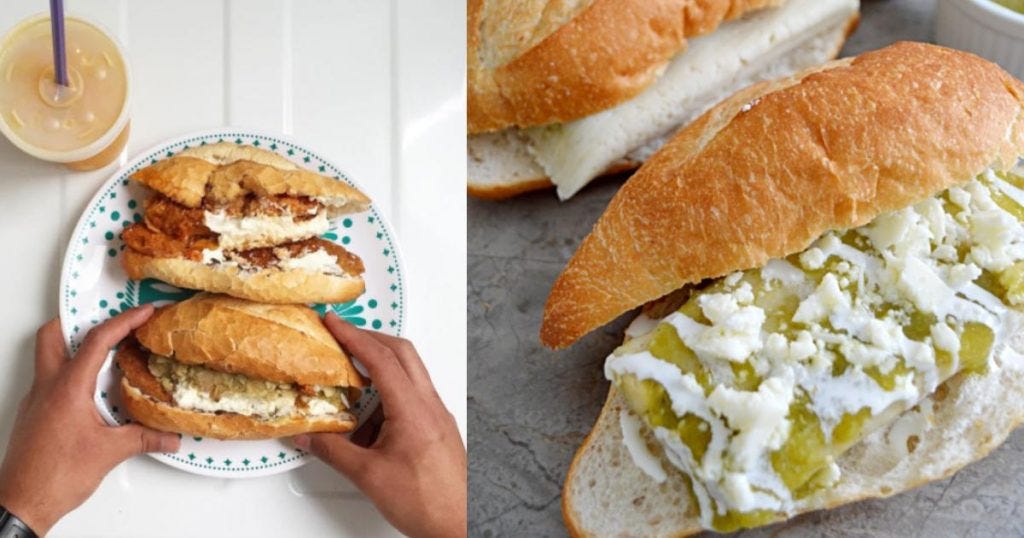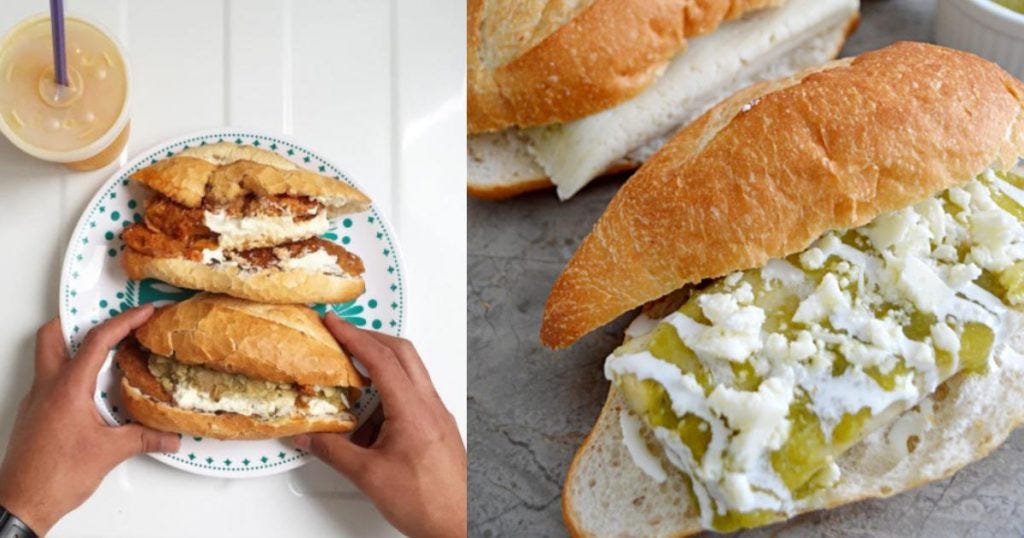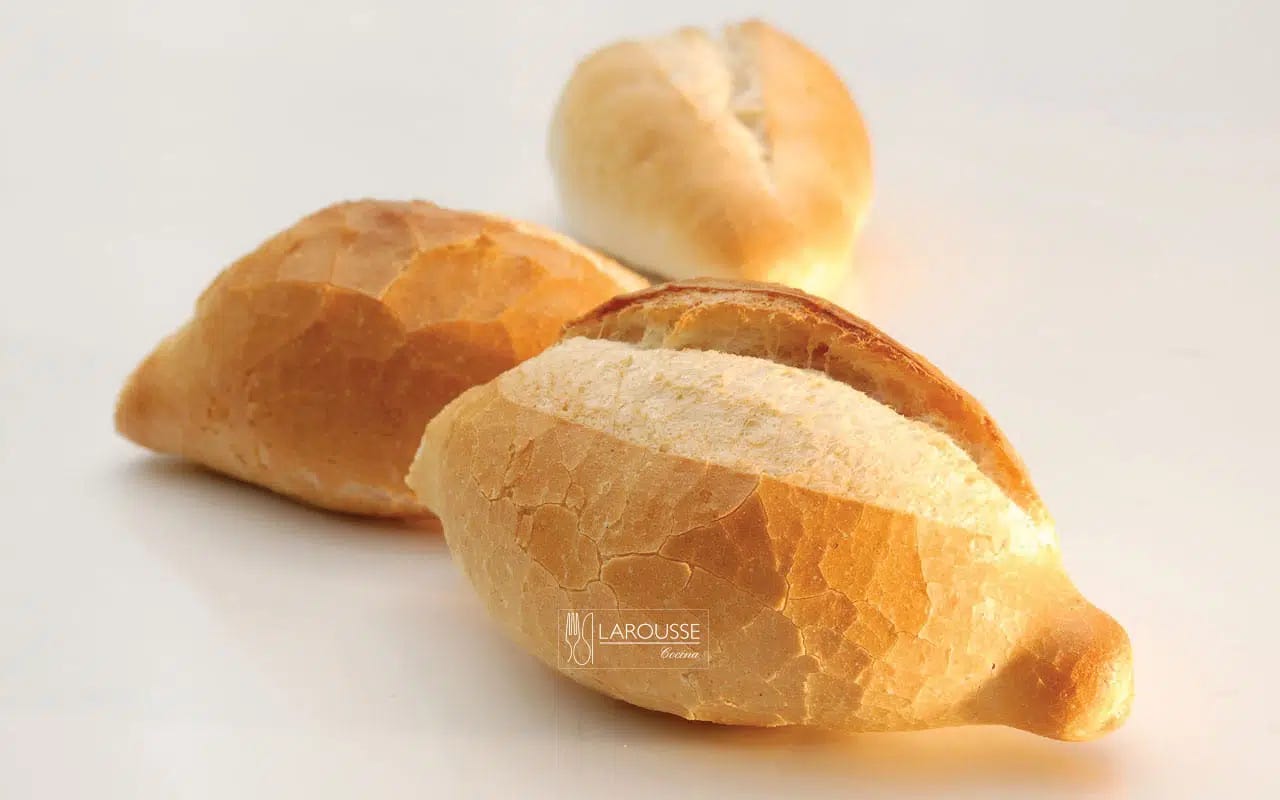Notable Sandwiches #77: Guajolota
A Mexican street-food sandwich and a meditation on mush
Welcome back to Notable Sandwiches, the feature where I, alongside my editor David Swanson, trip merrily through the odd mutable ranks of Wikipedia’s List of Notable Sandwiches. This week: a Mexican street-food classic, the guajolota.
NOTE TO READERS: For the first time in nearly 300 posts, I am working bereft of an editor today, because David is moving house & quite busy. As you’ll no doubt see in this post, by his absence he proves his necessity – we’re a two-person team, and he’s the guy who, in addition to contributing a lot of amazing content (no one can do an archive roundup better), turns the incoherent Google Docs I send him at 4am into polished posts with art and headlines and stuff. It’s very much a partnership for which I am incredibly grateful, but I pay his salary out of your subscriptions – so if you’d consider upgrading to a paid subscription so I can continue to text him at wild hours indefinitely, we’d appreciate it!
In the beginning of the world, there was mush.
There’s been a lot of interpretation about Genesis 1:2, which uses the Hebrew phrase tohu va-vohu to describe the universe before divine intervention. While it’s generally taken as something like “without form and void” (per the KJV) or “unformed and void” (Jewish Publication Society), I prefer to think of it as, well, mush. Something soft and doughy and waiting to be plied into shape, molded and heated by the fires of creation into the delicious strange world that it became.
Incidentally, the etymology of mush helps out here – it’s a 1670s variant on “mash” from the American colonies, “mash” coming from late Old English *masc (in masc-wyrt "mash-wort, infused malt"), from Proto-Germanic *maisk- (source also of Swedish mäsk "grains for pigs," German Maisch "crushed grapes, infused malt," Old English meox "dung, filth") according to the indispensable etymonline.com. It’s a bunch of stuff mixed together with liquid – ready to be liquor or filth or to feed pigs or ourselves, or become a world.
We begin our lives with mush, the soft stuff, whether it’s baby food in a can or soft boiled carrots mashed for the baby or similar, winding up smeared all over infant cheeks. Our teeth aren’t there yet, and they come in painfully, and mush sustains us in the brief interim after milk, makes us big and whole. And at the end of life mush returns, because teeth leave, painfully, too – life is arguably just the interval between periods of toothlessness. One of the most beautiful food essays I’ve ever read is Oliver Sacks’ deathbed essay about gefilte fish, a soft Jewish delicacy that by its softness similarly interleaves birth and death. “While I have conscious memories of gefilte fish from about the age of four, I suspect that I acquired my taste for it even earlier, for, with its abundant, nutritious jelly, it was often given to infants in Orthodox households as they moved from baby foods to solid food,” Sacks wrote a few months before he died, in 2015. “Gefilte fish will usher me out of this life, as it ushered me into it, eighty-two years ago.”
The locus for this meditation on mush is the guajolota, alias torta de tamal, a Mexico City street-food dish that consists of a roll stuffed with tamale filling. The mush – formed by steaming, adorned with piquant sauces and an array of proteins – is unwrapped from its cornhusk and jammed into the roll, the better to eat on the go. Its origins are in Pueblo nearly two hundred years ago, but in its migration to the capital, the sandwich acquired a new name and a new bread – the round, plump bollilo. Folk etymology for the sandwich, which is a feminized form of guajolote, the Spanish word for “turkey,” offers various options: it’s either named for its rotund shape, reminiscent of the noble swell of the bird’s breast, or for its calorific nature – it’s carb-on-carb, bread x corn crossover goodness, and will fatten you up like a turkey for the roasting.
Either way, it is the most convenient carrier imaginable for mush, which otherwise pools in the hand and forms itself around your fingers most impolitely. The mush in question is tamale filling, a mix of corn dough (masa harina), broth, fat and spices, which is steamed in a cornhusk or banana leaf until taking on comparative solidity and shape. It’s turned out from the husk for consumption, although in the guajolota’s case, it’s encased anew for a waiting hand, still giving and pliant within.
The similarity in sound between masa and mush is likely coincidental – as established above, mush/mash is firmly rooted in Germanic pig-feed traditions – but the way it sounds in the mouth had me thinking about what nourishes us when we need it. In the not too recent past, I was high off my damn gourd on a bunch of tabs of acid, spent several hours looking really closely at sage leaves, and at some point remembered that I had a body and it was hungry. LSD and eating don’t really go together extremely well, so I announced to the group that I needed some “nourishing pap.” In my hallucinogen-addled mind, this turn of phrase seemed extremely profound to me, and I kept repeating it, letting the words “nourishing pap” and then “pap” sound on my lips until my beleaguered boyfriend secured me a plate of yaroa – a Dominican plantain mash loaded with French fries and cheap meat, and a perfect fit for the occasion. Pap, I whispered gently into my spoon, overwhelmed. I felt the world had arrived at this moment of perfect nourishment, so soft and gentle, out of a beautiful confluence of the stars (instead of a guy paying a guy to show up from a restaurant with a bag of pap in a plastic container) and the pores of the sage leaves looked like galaxies to me.
It’s at this point that I developed my theory that the universe began from mush, although that’s the only insight I retained from that trip to the Timothy Leary plain of mental existence. (I haven’t been back – my brain sucks so badly I’m afraid to mess with it anymore – but when I think of nourishing pap, I remember that painstaking examination of the sage, and the ecstatic meeting of the yaroa and my mouth, the soft yielding plantain embodying all nourishment).
Theologically, Genesis’ vision of the pre-created universe is probably something like darkness and water, or a howling hole of nothing into which God spoke, but I prefer to return to my imaginings. I like to think of the proto-world as a corn dough shaped with gentle hands, this mound a mountain, this runnel to be filled with the salsa picante of a sea, this nub a tree, a shrub, this pock in the dough a bay upon whose mouth a city will someday grow. And someday a woman will be in that city, a woman who grew strong on mush and will grow frail on mush, and she thought about mush inbetweentimes, thought about making a world, about the brief interval between teeth that’s living, and celebrated, for an hour’s writing, the soft things within it, the things that fill us and warm us and gentle us through dark hard days.







I’m stuck on “guajalota”. I volunteer at a food pantry in an area where there are many people from the state of Michoacán. The word around here is “pavo”, but I was aware that there was at least one other word for “turkey” because of one of the volunteers who was born in Mexico City. Well, that said, I can now take in the rest of what you said.